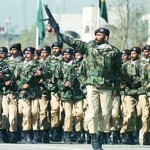IDR Blog
From 26/11 to San Bernadino and Pathankot: Understanding the Evolving Terror Paradigm
It is common knowledge that viruses of all types, be they health related or otherwise, move up the food chain and mutate from the simple to the more complex to ensure that they survive all attempts made to destroy them. Probably the only environment where we seem to have a contrarian trend concerns the virus of terrorism. As is amply borne out from the recent serial attacks in London, Paris and San Bernardino (California), the complexity and sophistication of the 9/11 attacks have given way to simple straightforward assaults.
Terrorism, unlike an insurgency, does not look to garner public support towards the cause. Thus, whether launched by a group or by an individual, these are geared towards causing maximum casualties in the shortest possible time and taking of hostages or negotiating the release of their own is no longer the aim. Though such assaults have resulted in relatively fewer casualties, their impact has been no less devastating on the communities attacked.
While the affected countries have been caught off-guard, this trend towards simplicity in planning and execution was not unexpected as Israel has been facing the brunt of these attacks, especially by “Lone Wolves” for the past two years.
These tactics gained prominence over the years as the Israeli-Palestinian conflict continued to be impacted by the overwhelming superiority of the Israeli Defence Forces (IDF) and the inability of the Palestinian groups like Hamas to launch coordinated attacks within Israel.
An added factor in the case of Israel has been the total lack of international condemnation for the massive and indiscriminate retaliation that they resorted to against militants and civilians alike. As more and more innocent Palestinian civilians, including women and children, became victims of collateral damage, the anger, resentment and frustration against Israeli action amongst law-abiding local residents erupted into individual acts of revengeful violence against members of the IDF and non-combatant Israeli’s alike.
While statistics are difficult to come by, on an average, there has been approximately one attack a month ever since 2014. Despite the fact that Israeli Security and Intelligence Agencies are known for their effectiveness, even they have been unable to either predict or detect such attacks prior to their execution.
The physical impact of these attacks has been minimal with Israeli casualties restricted to a few dozen over the two years, while in all these incidents the perpetrators have been neutralized fairly quickly. Yet, it has led to a palpable climate of fear, turmoil and hatred within the social fabric of the community, making it all the more harder to work towards a peaceful resolution of the problem within the region.
This phenomenon is also seen elsewhere as after the attack in California, for example, we have the leading Republican Presidential contender, Donald Trump, stating unequivocally that Muslims should not be permitted to enter the United States. This is despite the fact that as per Pew Research Center, the US has 2.6 Million followers of Islamas of 2010 and is likely to rise to approximately 5 Million by 2030 as per estimates.
As is to be expected in these circumstances, the Police and other security agencies have been unable to come up with any cogent preventive counter-measures except to increase numbers on the ground.
This in itself is of limited value, as the initiative of selecting time and place of attack clearly rests with the attacker and it is practically impossible to provide protective cover in all areas at all times. In their paper on the subject of “Preventing Lone Wolf Terrorism: some CT Approaches Addressed”, Profs Edwin Bakker and Beatrice de Graaf of Leiden University, have suggested that instead of focusing on identifying potential attackers, which is extremely difficult, it may be more effective to focus on how such attacks are executed.
This requires an understanding of the radicalization process and formulating processes that involve community engagement and the sensitizing of family members. It also requires intervention that leads to the de-legitimization of perpetrators and their acts and the falsification of their ideologies through effective public awareness campaigns in schools, universities and through social media.
In practical terms the requirement for a responsive and integrated communication network, both within police and intelligence agencies and for informing the public is of paramount importance. The modus operandi of these attacks has quite clearly shown that the perpetrators ability to procure weapons is directly proportional to the casualties likely to occur. The attack in California, where weapons are comparatively easier to procure, clearly highlights this point when compared to the knife attack in London, where gun control laws are far stricter.
In addition, given that terrorists are aiming at maximum casualties, response times of security agencies and the Police to counter such attacks are also critical in controlling casualties. In this context, the importance of centrally controlled specialized intervention units like the NSG and the German GSG9 has greatly reduced and there is now a need for intervention teams, albeit with limited capability, to be located within police districts of each and every major town in the country.
In our context after the Mumbai attacks of 26/11, which was also directed at inflicting maximum casualties and damage, we have expanded our NSG assets and distributed them on a regional basis so that response times are reduced.
While a repeat of such attacks is a distinct possibility, given that little effort has gone into enhancing our surveillance and dissuasive capabilities in practical terms, the necessity of upgrading local police forces to respond against “Lone Wolf” attacks has become all the more essential and requires to be given additional attention.
If we had such localized capabilities in place before the Mumbai attack and if we were to consider each of the individual incidents that went into the 26/11 attacks in isolation, whether it was the attack on Chhatrapati Shivaji Terminus, Leopold Café, Cama Hospital, Nariman House or the Trident and Taj Mahal Palace Hotels, and had responded against each individual attack effectively, the likelihood of the attackers being neutralized earlier with lesser casualties would have been a distinct possibility.
The recent Pathankot attacks, however, clearly showed us the drawbacks and futility of utilizing specialized hostage rescue or intervention forces in search and destroy tasks. In fact, given the enormous dichotomy within the NSG because of its mixed force structure, it may be worthwhile to re-evaluate its organization and tasking to meet current needs.
In that context, the Special Action Groups which are purely from the Army and oriented towards hostage rescue and intervention could be brought under the ambit of the Tri-Services Special Operations Command, the formation of which is reportedly under active consideration.
The Special Ranger Groups could be expanded under the NSG to provide VIP protection, which they presently carry out despite it not being a legitimate task, and for providing Special Weapons and Tactics Teams (SWAT) to local police forces in metros and two/three tier cities.
This will ensure that while we continue to maintain assets for conduct of specialized intervention tasks, our ability to respond to lone wolf or terror attacks such as the one at Dinanagar are greatly enhanced and are coordinated by a centralized police headquarters.





